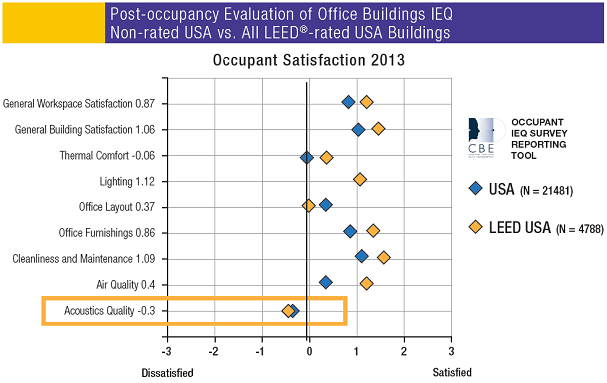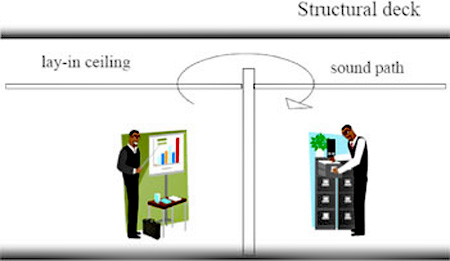Introduction
Within This Page
The acoustical environment of a workspace is often given little or no attention during project planning and design. The functionality and aesthetics of the workspace are usually the primary focus of the designer. Sometimes overlooked, are the factors contributing to the productivity of employees occupying the workspace. Providing a comfortable environment for employees contributes significantly to their optimum performance and reduced absenteeism. Workspace comfort is a combination of factors that includes daylighting and electric lighting, indoor environmental quality, temperature, and acoustics. The assault on ears in the workplace can come from traffic noise outside, mechanical equipment in adjacent spaces, and copiers, phones, and voices within the workspace.
Description

The focus of this resource page is primarily on acoustic comfort in offices, classrooms, and conference rooms, though the concepts may apply to other space types, as well. For other occupancies see the references at the end of this page.
Besides the design team's focusing on the project's functionality and aesthetics, building acoustics is so often given low priority because it competes for limited project dollars with a number of other project goals, including: sustainable design/development, physical security/anti-terrorism, information technology/telecommunications, and building automation and controls. What is the solution to incorporating acoustics into the project development process? Employ an integrated design approach.
Though there are some differences in the acoustical requirements of offices, classrooms, and conference rooms, several common noise problems affect these occupancies:
- Too much noise outside the building entering the space
- Too much noise from adjacent spaces, and
- Lack of sound control within the space itself.
Noise in these occupancies is typically not at a high enough level to be harmful to human hearing. Rather, the noise is distracting from concentration on work or study and provides less than ideal working and learning environments.
For each of the covered workplace occupancies, this paper will:
- address the sources of acoustical problems
- offer design guidance to control the acoustical problems
- identify accepted acoustical criteria, and
- describe the value of acoustic comfort to the employee.
Site Selection
A satisfactory indoor acoustical environment actually starts by knowing what is going on outdoors. Follow these guidelines when selecting a site for an office building or educational facility:
- Avoid sites in high noise areas—airfields, highways, factories, and railways.
- Ensure compatibility with existing facilities—do not site a school in an industrial area, for example.
Determine what else is planned for the site in the future. Your building may be the first one built, but if future buildings are acoustically incompatible with yours, significant remediation measures may be necessary to return the interior sound environment to an acceptable level.


When the site is predetermined and is too noisy for an office building or educational facility:
- incorporate appropriate sound control measures
- avoid through-the-wall, package terminal air conditioners (PTAC)
- orient quiet spaces away from outside noise sources.
To protect the spaces in a building from noise from a nearby highway or railway, lay out the building so that restrooms, mechanical and electrical equipment rooms, and other less noise-sensitive spaces are adjacent to the roadway. When designing a campus near high noise activity, locate gymnasiums and other less noise-sensitive facilities closer to the noise source and place buildings needing quiet surroundings in the shadow of those facilities.
As always, while siting for noise control, incorporate sustainable site planning into the decision-making process.
It is more likely for a project to remain within budget if opportunities are sought to apply a single design approach to achieve multiple design objectives.
For example, an earth berm with low-growth, drought-tolerant plants can act as a noise barrier from highway traffic, meet sustainable development principles, and help meet security requirements for standoff distance from buildings.
Glazing
Windows and glazing are key elements of the building envelope. These elements must allow daylight to enter the space, reject heat and glare, control sound and, for some projects, be blast resistant. The extent of windows and glazing, and their size and location are decisions that must be made in the project concept phase to ensure proper windows and glazing are chosen. Keep in mind that multiple glazing types are likely for many projects based on the building orientation, proximity of intrusive noise sources, and vulnerability assessments and risk analysis.
A. Open Office Environments and Teaming Spaces
Teaming Spaces are flexible areas designed to foster collaboration and innovation. Open office environments provide greater flexibility than enclosed offices by using easily relocatable low-height, moveable partitions or systems furniture to form individual workspaces, rather than employing full-height permanent partitions. The initial cost for teaming spaces and open office environments may be significantly less than that for enclosed offices and reconfiguration can be done rapidly at minimal cost. These factors have led to an increased use of teaming spaces and open office environments in both the federal and private sectors. Acoustical problems have surfaced in teaming spaces and open office environments causing employee distraction, stress, and interference with team interaction, and normal work routines. How serious is the problem of poor workplace acoustics? The Center for the Built Environment (CBE) at U.C., Berkeley conducted post-occupancy Evaluations (POE) of many buildings over the years with respondents in a variety of office configurations. A majority of occupants in these environments think poor acoustics interfere with their ability to do their work.

Occupant Satisfaction 2013
Credit: The Center for the Built Environment (CBE) at U.C., Berkeley
Though occupants of green buildings generally show a higher level of satisfaction with the built environment than do occupants of standard buildings, these buildings fall short in some key areas. Common complaints included: acoustics (too noisy, not enough privacy), thermal comfort (limited temperature control), and daylighting (too much glare and light spill).
Contributors to unacceptable noise in the workspace include indiscriminate use of speakerphones, low partition heights, ringing phones, noisy copy machines, and office chatter.
Solutions:
- Locate teaming spaces and open office environments away from reception areas and other high traffic areas not associated with these spaces.
- Specify acoustical ceilings with a noise reduction coefficient (NRC) of 0.75.
- Choose systems furniture with a 60 inch minimum height and have sound absorbing surfaces on both sides.
- Avoid placing lighting fixtures directly over partitions—they reflect sound to adjacent work areas.
- Locate printers/copiers in separate rooms away from offices and provide separate ventilation to minimize ozone in the workspace.
The ideal office environment should give workers individual control of temperature, lighting, and acoustics in their personal workspace.
B. Conference Rooms and Private Offices
Though conference rooms and private offices have stationary partitions from the floor to the suspended acoustical ceiling, acoustical problems can still occur.
Most workplace environments should have quiet havens—places where private conversations can occur without being heard in adjacent rooms or passageways for employee matters, contract negotiations, classified discussions, etc.
Some problems that occur in private offices:
- inability to have private discussions
- can hear sounds through partitions
- too noisy in room
- can hear sounds from air return registers

Sound can travel over partition walls and through the suspended acoustical ceiling. To be an effective sound barrier between rooms, partitions need to extend to the structural deck.
Solutions:
- Extend walls from floor to structural deck above.
- Insulate partition cavity/increase partition sound transmission class (STC).
- Specify NRC of 0.75 for ceiling tiles.
- Employ ducted air return system.
- Do not locate mechanical equipment rooms next to offices and conference rooms.
STC values for various occupancies can be found in UFC 3-450-01 Noise and Vibration Control and Architectural Graphic Standards.
C. Classrooms
Classrooms are environments designated for learning, not just for school-age children, but for adult education as well. Classrooms have become multimedia communications environments, further increasing the importance of classroom acoustics.
Good acoustics for learning support easy verbal communication, which requires low noise levels and very little reverberation. In the past, classrooms may have been constructed without adequate consideration of sound acoustical principles. Sources of noise hampering students' concentration include:
- outside of the school (vehicular traffic and aircraft flyover)
- the hallways (foot traffic and conversation)
- other classrooms (amplified sound systems and inadequate partition sound transmission loss)
- mechanical equipment (compressors, boilers, and ventilation systems), and
- inside the classroom itself (reverberation).
To reduce noise from adjoining classrooms, do not have doors adjacent to each other or have doors directly across from each other. Rather, offset the door locations to extend the sound travel path from one classroom to the next. This strategy works well with conference rooms and private offices as well.
The Acoustical Society of America (ASA) recognized the value of a high-quality acoustical learning environment. The results of their efforts led to the publication of ANSI/ASA S12.60 American National Standard Acoustical Performance Criteria, Design Requirements, and Guidelines for Schools. This Standard provides acoustical performance criteria, design requirements, and design guidelines for new school classrooms and other learning spaces. The standard may be applied when practicable to the major renovation of existing classrooms.
Application
Daylighted Offices and Classrooms
When open ceilings are designed into a building project to optimize daylighting into offices and classrooms, quite often suspended acoustical ceilings are eliminated and the exposed surfaces are painted with highly reflective paint to throw daylight well into the space. The sound absorption value lost by the absence of the suspended ceiling must be replaced in other ways to prevent the space from becoming a highly reverberant field. High reverberation times are not conducive to concentration and effective learning.
For office areas with exposed ceiling structure, specify low reverberation times (0.6–0.8 seconds) to minimize echoing and unwanted sound reinforcement.
In other words, the majority of the effective sound absorbing materials in a space are in the suspended acoustical ceiling. If a space is designed without a suspended acoustical ceiling, sound absorption must be provided somewhere else: partitions, banners, drapes, etc.
Carpet on the floor does not replace the lost overhead sound absorption though it reduces footfall noise.
HVAC Noise Issues
HVAC systems should be specified to have an ambient sound level compatible with the occupancy. If HVAC system is too noisy, conversation may be difficult. If HVAC is too quiet, unwanted conversations and other distracting noises will be heard. Productivity is affected. Follow recommended background noise reduction design criteria for typical occupancies in Architectural Graphic Standards. For example, in office buildings:
- small conference rooms: NC 30–35
- small private offices, libraries: NC 30–35
- general offices: NC 35–40
- computer rooms: NC 40–50
HVAC acoustical strategies:
- Avoid through-the-wall air return louvers that draw air from one room through another in private offices, conference rooms, and other rooms where confidential discussions are expected to occur. All air returns should be ducted.
- Do not locate air supply or return registers close to each other on opposite sides of a partition wall. Doing so will cause sound to pass directly from one room to another, negating the acoustical value of the partition.
- Specify quiet HVAC equipment. Though the price may be somewhat higher, the alternative of using standard equipment may lead to costly and disruptive remediation.
Natural Ventilation
Natural ventilation using operable windows is desirable in appropriate climate zones. Before committing to that strategy, be aware of the outdoor acoustical environment around the building. Unacceptable levels of continuous or intermittent noise outside can preclude the use of this sustainable design strategy.
Sound Masking
- What is it? — Sound masking introduces unobtrusive background sounds into the office environment to reduce interference from distracting office sounds and render speech from coworkers virtually unintelligible.
- Where and when to use it? — In open and closed office designs when ambient sound level is too low.
- Why use it? — To increase productivity, improve worker morale, and enhance speech privacy.
Sound masking works by producing sound electronically, similar to that of softly blowing air, which is projected through speakers installed above the tiles in the ceiling. This sound is evenly distributed throughout the area being masked and can be adjusted to the individual privacy requirements in any given area. In an open plan office without a suspended ceiling, speakers could be set on the systems furniture or even under the raised floor.
Sources for sound masking systems include Dynasound, Lencore, and LogiSon.
Sustainability and Acoustics
There may be opportunities to meet project sustainability goals in conjunction with good acoustical design if they are considered early in the project development phase. For example, a reinforced concrete wall may be recommended as a passive solar design strategy. If the building is located next to a busy highway or railway, that wall could provide the necessary sound transmission reduction to achieve an acceptable indoor acoustical environment. For projects having security requirements, that same wall could serve to mitigate blast. The key is getting the acoustical, security, and sustainability consultants involved at project conception and to apply the integrated design process throughout the project.
Acoustical products like ceiling tiles, insulation, and carpeting, among others can help meet the project's sustainability goals since many of them are recyclable or are manufactured from recycled content. Ceiling tile and carpet tile manufacturers 'take back' their products that are damaged or at end-of-life. These programs are helping to eliminate the huge amounts of carpet and ceiling tile that used to end up in landfills.
The U.S. Green Building Council's (USGBC) Leadership in Energy and Environmental Design (LEED) for Schools Rating System is the first green building rating system to include both an acoustics prerequisite and credits for classroom design.
Fire Safety
Be sure acoustical materials meet applicable fire resistance requirements. Do not use bedding or packing foam as sound absorbers—they are not the same as tested acoustical foam. See the National Institute of Standards and Technology (NIST) Station nightclub fire investigation.
Directional sound is a relatively new technology in fire safety. It is an audible means to lead people to safety. The varying tones and intensities coming from directional sound devices offer easy-to-understand cues for finding the ways out. Advantages of directional sounders:
- can lead people of all languages to exit
- audible clues can direct people with visual impairments
- especially helpful in smoke-filled environments
- upward or downward sweeping tones alert occupants to go up or down stairways to exit building.
Related Issues
Though acoustics and noise control in buildings remain one of the least recognized design objectives, recently, certain organizations have recognized the importance of including acoustics in green building standards and post occupancy evaluations. The USGBC LEED v4.1 rating system now offers credits for improving acoustic performance in both the Building Design and Construction and Residential categories. The Center for the Built Environment (CBE) pioneered the inclusion of acoustic comfort and satisfaction in post occupancy evaluations. More recently, leading design firms and federal agencies that apply the integrated design process to their projects are including acoustical considerations in planning and design through occupancy evaluations.
Multi-Family Residential: Higher-end condos and apartments along with senior living communities have also begun considering acoustic comfort in their designs. For example, these homes are including design strategies like staggered stud walls, avoiding back-to-back electrical outlets, plumbing noise control, high efficiency windows, water hammer arrestors, and designing adjacent units for compatible occupancies e.g. bedroom to bedroom, laundry room to laundry room, and garage to garage.
A Quieter America: The Institute of Noise Control Engineering of the USA (INCE-USA) announced a new website: A Quieter America to provide knowledge about noise and noise control for the public. As part of its mission, INCE-USA enables a quieter world through education, awareness, advocacy, and technical advancement. The site provides information defining noise and its impact on health and quality of life in an easy-to-understand format for readers from school age to professionals in related fields. Additionally, there is information about controlling noise with detailed information on specific noise issues.
Relevant Codes and Standards
Industry
- ANSI/ASA S12.60/Part 1 Acoustical Performance Criteria, Design Requirements, and Guidelines for Schools—Part 1: Permanent Schools
- ANSI/ASA S12.60/Part 2 Acoustical Performance Criteria, Design Requirements, and Guidelines for School—Part 2: Relocatable Classroom Factors
- ASHRAE HVAC Applications Handbook, Chapter 48, Sound and Vibration Control
- ASTM E1374 Standard Guide for Open Office Acoustics and Applicable ASTM Standards
- ASTM E33.02 (1998) Open office acoustics. White Paper. ASTM Standardization News, 26 (12), 39-47.
Government
- DG 1110-3-122 Design Guide for Interiors (Acoustics, p.5.5)
- UFC 3-450-01 Noise and Vibration Control
- UFGS 09 51 00 Acoustical Ceilings
- UFGS 09 84 20 Acoustical Wall Panels
- UFGS 10 22 26.13 Accordion Folding Partitions
- UFGS 10 22 39 Folding Panel Partitions
- UFGS 10 22 43 Sliding Partitions
Additional Resources
Organizations and Associations
- Acoustics.com—A Professional Design Resource
- Acoustical Society of America (ASA)
- American Speech-Hearing-Language Association (ASHA)
- American Society of Interior Designers (ASID)
- Institute of Noise Control Engineering of the USA (INCE-USA)
- National Council of Acoustical Consultants (NCAC)
References
- Acoustic Quality in Office Workstations, as Assessed by Occupant Surveys Jensen, K., and E. Arens. Proceedings, Indoor Air 2005, Beijing, China, Sept. 4-9, 2005.
- Architectural Graphic Standards 12th Edition by The American Institute of Architects. Available from John Wiley & Sons, Inc., 2016.
- Classroom Acoustics II: Acoustical Barriers to Learning by Acoustical Society of America. Melville, NY, 2002.
- National Research Council Canada—Acoustics Research
- NIH Design Policy and Guidelines (p. 15), 2016.
- PBS-P100 Facilities Standards for the Public Buildings Service, GSA. (Section 3.4, Special Design Considerations-Acoustics), 2021.
- Sound Matters: How to achieve acoustic comfort in the contemporary office by the GSA Public Buildings Service. 2011.
- Sound & Vibration 2.0: Design Guidelines for Health Care Facilities by the Acoustics Research Council. 2013.
- U.S. Courts Design Guide by the Administrative Office of the U.S. Courts and General Services Administration (GSA). Washington, DC, 2021.
Tools
- GSA Sustainable Facilities Tool (SFTool)—SFTool's immersive virtual environment addresses all your sustainability planning, designing and procurement needs.
- USGBC LEED v4.1 building rating system








